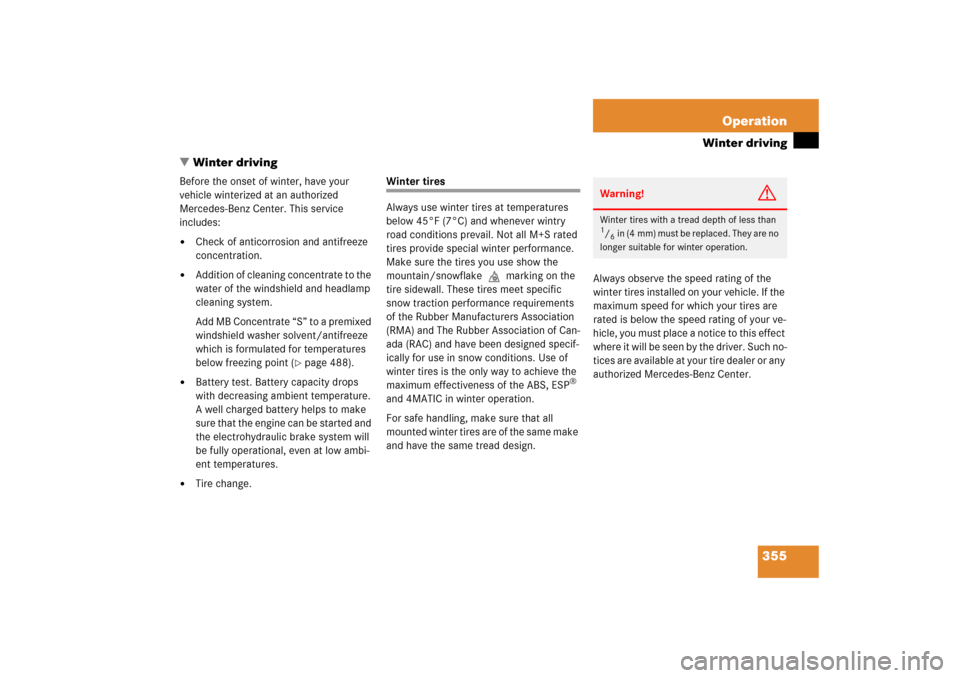Page 352 of 521

351 Operation
Tires and wheels
DOT (D
epartment o
f T
ransportation)
A tire branding symbol which denotes the
tire meets requirements of the
U.S. Department of Transportation.
GAWR (G
ross A
xle W
eight R
ating)
The GAWR is the maximum permissible
axle weight. The gross vehicle weight on
each axle must never exceed the GAWR for
the front and rear axle indicated on the
certification label located on the driver’s
door B-pillar.
GVW (G
ross V
ehicle W
eight)
The GVW comprises the weight of the
vehicle including fuel, tools, spare wheel,
installed accessories, passengers and
cargo and, if applicable, trailer tongue
load. The GWV must never exceed the
GWVR indicated on the certification label
located on the driver’s door B-pillar.GVWR (G
ross V
ehicle W
eight R
ating)
This is the maximum permissible vehicle
weight of the fully loaded vehicle (weight of
the vehicle including all options, passen-
gers, fuel, and cargo and, if applicable,
trailer tongue load). It is indicated on
certification label located on the driver’s
door B-pillar.
Kilopascal (kPa)
The metric unit for air pressure. There are
6.9 kPa to 1 psi; another metric unit for air
pressure is bar. There are 100 kilopascals
(kPa) to 1 bar.
Maximum load rating
The maximum load in kilograms and
pounds that can be carried by the tire.
Maximum loaded vehicle weight
The sum of curb weight, accessory weight,
vehicle capacity weight and production
options weight.Maximum tire inflation pressure
This number is the greatest amount of air
pressure that should ever be put in the tire
under normal driving conditions.
Normal occupant weight
The number of occupants the vehicle is
designed to seat, multiplied by
68 kilograms (150 lbs).
Occupant distribution
The distribution of occupants in a vehicle
at their designated seating positions.
Production options weight
The combined weight of those installed
regular production options weighing over
5 lbs (2.3 kilograms) in excess of those
standard items which they replace, not
previously considered in curb weight or
accessory weight, including heavy duty
brakes, ride levelers, roof rack, heavy duty
battery, and special trim.
Page 356 of 521

355 Operation
Winter driving
�Winter driving
Before the onset of winter, have your
vehicle winterized at an authorized
Mercedes-Benz Center. This service
includes:�
Check of anticorrosion and antifreeze
concentration.
�
Addition of cleaning concentrate to the
water of the windshield and headlamp
cleaning system.
Add MB Concentrate “S” to a premixed
windshield washer solvent/antifreeze
which is formulated for temperatures
below freezing point (
�page 488).
�
Battery test. Battery capacity drops
with decreasing ambient temperature.
A well charged battery helps to make
sure that the engine can be started and
the electrohydraulic brake system will
be fully operational, even at low ambi-
ent temperatures.
�
Tire change.
Winter tires
Always use winter tires at temperatures
below 45°F (7°C) and whenever wintry
road conditions prevail. Not all M+S rated
tires provide special winter performance.
Make sure the tires you use show the
mountain/snowflake.marking on the
tire sidewall. These tires meet specific
snow traction performance requirements
of the Rubber Manufacturers Association
(RMA) and The Rubber Association of Can-
ada (RAC) and have been designed specif-
ically for use in snow conditions. Use of
winter tires is the only way to achieve the
maximum effectiveness of the ABS, ESP
®
and 4MATIC in winter operation.
For safe handling, make sure that all
mounted winter tires are of the same make
and have the same tread design.Always observe the speed rating of the
winter tires installed on your vehicle. If the
maximum speed for which your tires are
rated is below the speed rating of your ve-
hicle, you must place a notice to this effect
where it will be seen by the driver. Such no-
tices are available at your tire dealer or any
authorized Mercedes-Benz Center.
Warning!
G
Winter tires with a tread depth of less than 1/6in (4 mm) must be replaced. They are no
longer suitable for winter operation.
Page 515 of 521

514 IndexV
Vacuum line routing diagram label 468
Vehicle
Battery 452
Care 362
Control system, settings menu 155
Dimensions 480
Individual settings 165, 167
Locking/unlocking 34, 59, 106
Locking/unlocking in an
emergency 424, 425
Lowering 450
Modifications and alterations, Operat-
ing safety 16
Towing 458
Washing 362
Weight 481
Vehicle capacity weight 353
Vehicle Identification Number see VIN
Vehicle jack 421
Vehicle level control see Airmatic DC (Dual
Control)*
Vehicle lighting 314Vehicle loading
Cargo tie-down rings 264
Instructions 263
Load limit 330
Terminology 350
Vehicle maximum load on the tire 353
Vehicle Recovery services, Stolen (Tele
Aid) 290
Vehicle status message memory 164
Vehicle tool kit 419
Vehicle jack 421
Vehicle washing 364
VIN 496
Voice control system* 496
W
Warning lamps see Lamps, Indicator and
warning
Warning sounds
Distance warning function* 252
Distronic* 246
Parking brake 53
Seat belt telltale 72
Warranty coverage 467
Washer fluid see Windshield washer fluid
Washer reservoir level 490
Washing the vehicle 362Wear pattern, Tires 353
Weight, Vehicle 481
Wheel
Change 445
Removing 447
Spare 447
Tightening torque 450
Wheels, Sizes 474
Wheels, Tires and 324
Window curtain air bags 72
Windows see Power windows 231
Windows, cleaning 366
Windshield
Cleaning 56
Cleaning wiper blades 366
Defogging 209, 224
Windshield washer fluid 490
Message in display 416
Mixing ratio
Refilling 323
Wiping 56
Windshield washer system 490
Windshield wipers 55
Replacing wiper blade 438, 439